Credits: Biovision-Infonet
There are two main types of water tanks, namely:
1) Ground tanks that are built below the ground level. These are mainly used for storage of dirty run-off water from roads and compounds. Ground tanks can also be used as storage for clean domestic water if the tanks are roofed and connected to gutters attached to roofs or rocks.
2) Surface tanks standing on the ground level which are cylindrical and mainly used for storage of run-off water from roofs and rocks.

(c) E. Nissen-Petersen, Kenya
Ground tanks should always be designed as either hemi-spherical (half ball shape) or cylindrical because those shapes equalize the pressure of water and soil whether the tanks are full or empty.
This hemi-spherical tank (see image above) built of burnt bricks reinforced with barbed wire and chicken mesh is for roof catchment of domestic water.
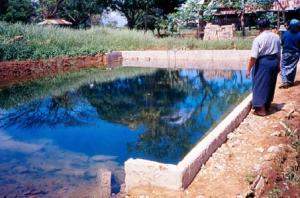
(c) E. Nissen-Petersen, Kenya
This photo shows a rectangular tank for fish farming in Myanmar. Two sides of the tank caved in when the tank was emptied of water due to pressure from the soil.
Note: Water tanks should never be designed using square and rectangular shapes because they will collapse due to the uneven pressure of water and soil whether the tanks are full or empty.
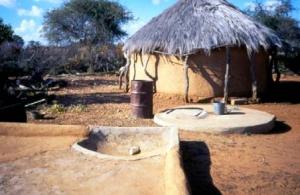
(c) E. Nissen-Petersen, Kenya
A traditional underground cylindrical water tank at a homestead in Botswana from which water is drawn by a bucket tied to a rope.
The catchment area for the tank is the threshing floor for millet and sorghum, which is made water repellant with a coat of cow dung.
The floor slopes towards a silt trap where a plastic bottle prevents mice and lizards entering the tank.

(c) E. Nissen-Petersen, Kenya
A simple and cheap ground tank can be made by excavating a cylindrical hole and plastering it with mortar cement onto chicken mesh (Ferro-cement).
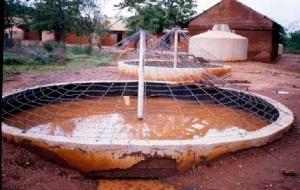
(c) E. Nissen-Petersen, Kenya
A series of two hemi-spherical ground tanks built of burned bricks collect and store run-off water from a school compound for irrigation of a tree nursery and small irrigation garden.
A roof catchment tank can be seen at the school building. It provides drinking water for the pupils.
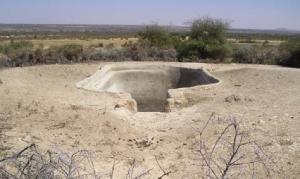
(c) E. Nissen-Petersen, Kenya
The berkad ground tanks for watering livestock in Somaliland are banned by the government because of environmental degradation due to over-grazing caused by insufficient fodder.
Moreover, most of the rectangular berkads must be repaired every year due pressure from the soil when the tanks are empty.

(c) E. Nissen-Petersen, Kenya
In Kenya, the rectangular berkad was redesigned to be oval-shaped and roofed with barbed wire covered with thorny Bougainvillea climbers, two large silt traps and a staircase made of concrete for drawing water by hand in buckets.
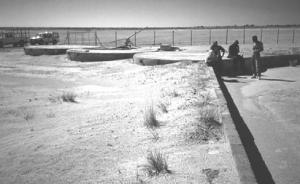
(c) E. Nissen-Petersen, Kenya
The hard sandy surface of the Kalahari Desert in Botswana is used as catchment area for these three large cylindrical water tanks, which provide domestic water for the San people (Bushmen).
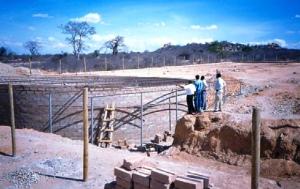
(c) E. Nissen-Petersen, Kenya
In the dry central plateau of Tanzania, a 500 m3 cylindrical water tank, made of reinforced concrete, was built to collect run-off water from a 2 sq.km catchment area. The water is for domestic use by the communities living nearby.
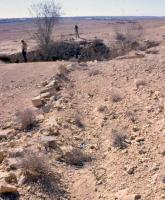
(c) E. Nissen-Petersen, Kenya
This ground catchment tank is known as “King David’s Well” in the Negev Desert of Israel and it is estimated to be about 2,500 years old.
The conical ground tank is lined with lime stones mortared together with lime mortar.
The catchment area is a large stony hill from where the annual rainfall of 100 mm falling in the month of December is diverted into the tank by long trenches sloping upwards from the tank.